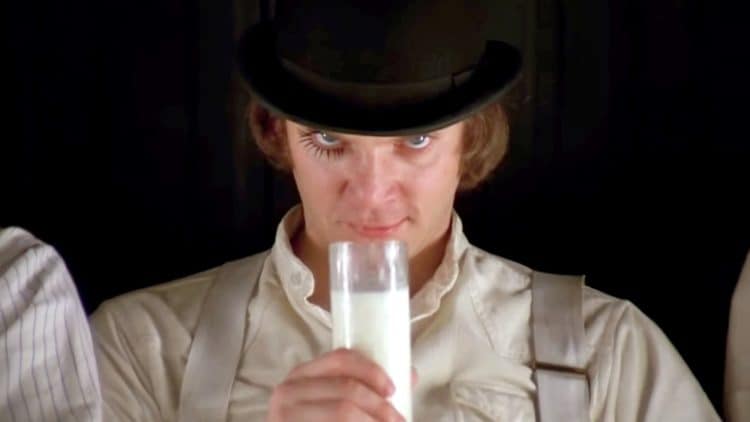
Stanley Kubrick’s A Clockwork Orange (1971) finely represents the crossroads between postmodernism in terms of its narratives. Chiefly the intersection between good and evil and how evil also rests firmly in the hearts and structures of the good within society–but the film is also a paradoxical work of postmodernism in how Kubrick fashions a singularly unique filmmaking process to tell Anthony Burgess’ story. With that in mind, the film is a stunning piece of filmic art while also being wholly postmodern in its narrative. According to Michael Z. Newman, some films can have “ambiguous or impossible ontological status within their fictional worlds, somewhere between objective reality and representation of fiction within fiction”. A Clockwork Orange has taken on mythic cult status in the half-century since its release. Consider the opening sequence that is a blank orange title card with Wendy Carlos’ chilling synth-driven rendition of Purcell’s music; the title cards are read and then the close-up of the protagonist/antagonist is held by the camera with sinister unease—it is still sends chills down my spine to this day and is a representation of Kubrick’s artistic prowess for a narrative that will unfold in unsettling and revealing displays of who within the film is truly evil and who is just a product of the system that builds the evil. But unlike today, where the film is still shocking to some new viewers, it was downright kryptonite in the early 1970s. Let’s take a look at why the film was so controversial.
Kubrick Positioned Both Sides of the Debate Between Good and Evil as Evil
The film is a great example of disjointed timelines in filmmaking in how we are never quite certain what the time and place of the events are, but we can assume it’s a futuristic setting. But Kubrick is more concerned with subliminally exploring how the forced reversal of violent impulses is no different from the violent actions being committed by rapists and thieves in the 20th century. Amidst the backdrop of stunning technical filmmaking, the narrative explores how Alex and his droogs go on daily sprees of robbing, assaulting, and sexually assaulting individuals within their community. The landscape is bleak and staid and suggests a future where the old concepts of corporatism, inequality, and totalitarian powers of the state are still regularly seen and in control. Are Alex and his droogs just bored, have they dropped out of systematic routines that come with capitalist societies? Is any of this truly the point? I don’t think it necessarily is or, I feel that Burgess and Kubrick are not drawing a line by condemning one or the other, the perpetrators of violence and mayhem or the state officials who try a new experiment that makes violent criminals physically ill when they think violent thoughts–or any thoughts that go against a superimposed morality.
When the experimental rehabilitation program known as the Ludovico Technique is tested on Alex as its first subject, we are left with a result that can in some ways mirror the bloodlust people feel over the death penalty. The treatment leaves Alex physically sick and repulsed during sexual attraction or an impulse that causes him to experience anger. It is therefore not an act of justice in terms of humane justice, but rather, violence begets violence and an eye for an eye. Those dishing out the cruel punishments of this sort are no different from the rapists.
X-Rating and Outbreaks of Violence in Britain
The film was met with sharp criticism by those who held these beliefs; the film was released and then pulled from British cinemas after Kubrick began to receive death threats in the mail; the film was also given an X rating by the MPAA and much of this was likely due to how uneasy viewers felt while watching violent assaults while the perpetrators sang along to “Singin’ in the Rain.” Kubrick’s ability to totally withdraw a film that was racking in the money for Warner Bros. is an astonishing display of the esteem and reverence that a major film studio had for one of its most artistic and respected filmmakers. It would be unthinkable in this day and age, even if a filmmaker such as Steven Spielberg decided to withdraw a profitable film from playing in theaters in an entire country. In contrast, according to Steven Jay Schneider writing about David Lynch’s Eraserhead (1977), A Clockwork Orange likely also suffered from those who “have attempted to mitigate the film’s cynicism and nightmarish qualities.” This is not surprising since the film holds nothing back and does not side with the narrative’s governmental structure that seeks to cure violence with violence. A brutal assault on the status quo that regulates law and order was likely never going to be met with wide-ranging support. The film’s closing sequence shows that although Alex has experienced retaliation and pushback on his behavior, you cannot change the fundamental structure of a violent mind–with that in mind, everybody is the villain in A Clockwork Orange. This is certainly the case when looking at how outbreaks of violence occurred all across Britain after the film’s release, with many of the perpetrators wearing costumes resembling the outfits worn by Alex and his gang in the film.
The Film Remains Shocking to This Day
51 years later, A Clockwork Orange has no doubt lost some of its bite. In the age of smart phones and ADD, it is unthinkable that new viewers will be quite as shocked as audiences were in 1971, who after all, lived in the moment at that time. But the film’s spellbinding and no doubt strange power, likely still gives new, modern viewers a tinge of unease when watching the proceedings. In 1971, scenes of graphic violence were not presented as mere comedy for those dishing it out–today, this is common in genre films, and there is no doubt that A Clockwork Orange has inspired all of them to a certain degree. But in the early 70s, this film was dangerous.Anthony Burgess’
 Follow Us
Follow Us




